The Dell PowerEdge R730 is packed full of functionality and flexibility making this solution an incredibly versatile. This mainly due to its use of powerful Intel processors, support for large memory footprint, fast storage options and GPU accelerator support, which makes it ideal for demanding and resource heavy environments. The R730 is also highly scalable when it comes to storage, as it supports up to sixteen 12Gb SAS drives that leverage the high-performance 12Gb PowerEdge RAID Controller (PERC9); the R730 has the ability to seriously accelerate data access within a virtualized environment. We also previously looked at Dell’s other model, the R730xd (the ‘xd’ meaning ‘extreme disk’), which is built for users that have larger storage application needs, as it uses a modified version of the chassis with its 28 bays.
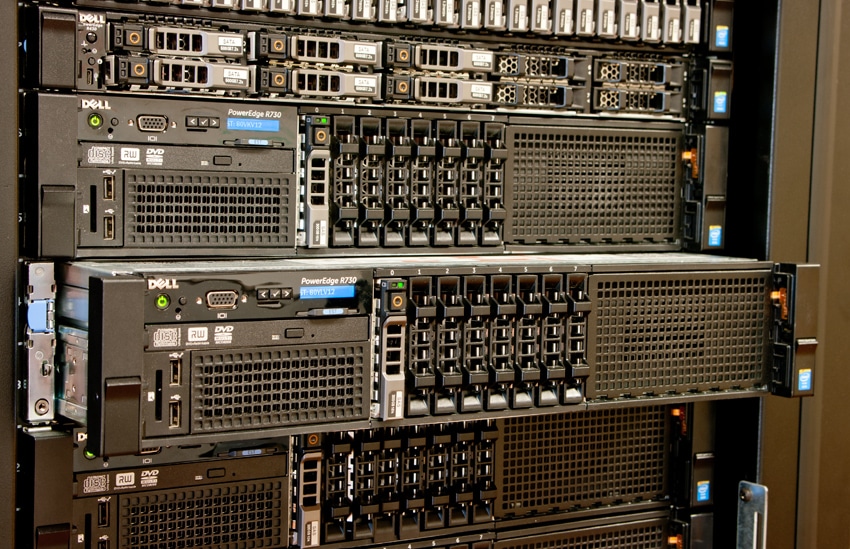
R730 also leverages the Dell Fluid Cache for SAN and SanDisk DAS Cache application acceleration technology, which helps increase I/O performance for OLTP and VDI workloads as well as boasting low-latency. The R730 is equipped with the Intel Xeon E5-2600 v3 processor and supports up to 24 DIMMs of DDR4 RAM. This hardware allows the Dell system ideal for data centers and cloud platforms, as it can process cycles and threads and large memory footprint necessary in order to boast larger and higher-performing virtual machines.
The Dell Rack Server also provides the option to choose up to four 150W single-width accelerators/GPUs or up to two 300W dual-width accelerators/GPUs from three different products: the Intel Xeon Phi, the NVIDIA Tesla and the AMD FirePro, all of which excel in environments where processing acceleration is required. This includes graphics-intensive VDI implementations, such as CAD/CAM, as well as other research and development applications. In addition, the R730 is equipped with seven PCIe Gen3 expansion slots and a dedicated slot for a RAID controller to help boost IO flexibility. As a result, Dell indicates that their rack server is well suited as a compute node for IT as a service (XaaS) providers or for high-performance computing and medical-imaging solutions.
Dell PowerEdge R730 specifications
- Processor: Intel Xeon E5 2600 v3 processors
- Operating System:
- Microsoft Windows Server 2008 R2
- Microsoft Windows Server 2012
- Microsoft Windows Server 2012 R2
- Novell SUSE Linux Enterprise Server
- Red Hat Enterprise Linux
- VMware ESX
- Chipset: Intel C610 series chipset
- Memory:
- Up to 1.5TB (24 DIMM slots): 8GB/16GB/32GB/64GB DDR4 up to 2133MT/s
- Embedded Hypervisor (Optional)
- Optional supported hypervisors:
- Microsoft Windows Server 2012, with Hyper-V
- Citrix XenServer
- VMware vSphere ESXi
- Optional supported hypervisors:
- Storage:
- HDD: SAS, SATA, Near-line SAS SSD: SAS, SATA
- 16 x 2.5” – up to 32TB via 2TB hot-plug SAS hard drives”
- 8 x 3.5” – up to 64TB via 8TB hot-plug NL SAS hard drives”
- Drive Bays:
- Internal hard drive bay and hot-plug backplane:
- Up to 16 x 2.5” HDD: SAS, SATA, Near-line SAS SSD: SAS, SATA
- Up to 8 x 3.5” HDD: SAS, SATA, Near-line SAS SSD: SAS, SATA
- Internal hard drive bay and hot-plug backplane:
- Slots:
- Slot configuration #1:
- Slot 1: Half Length, Half Height, PCIe Gen3 x8 (x16 connector) low profile bracket
- Slot 2: Half Length, Half Height, PCIe Gen3 x8 (x16 connector) low profile bracket
- Slot 3: Half Length, Half Height, PCIe Gen3 x8 (x16 connector) low profile bracket
- Slot 4: Full Length, Full Height, PCIe Gen3 x16 (x16 connector)
- Slot 5: Full Length, Full Height, PCIe Gen3 x8 (x16 connector)
- Slot 6: Full Length, Full Height, PCIe Gen3 x8 (x16 connector)
- Slot 7: Full Length, Full Height, PCIe Gen3 x8 (x16 connector)
- Dedicated RAID card slot
- Slot configuration #2:
- Slot 1: Half Length, Half Height, PCIe Gen3 x8 (x16 connector) low profile bracket
- Slot 2: Half Length, Half Height, PCIe Gen3 x8 (x16 connector) low profile bracket
- Slot 3: Half Length, Half Height, PCIe Gen3 x8 (x16 connector) low profile bracket
- Slot 4: Full Length, Full Height, PCIe Gen3 x16 (x16 connector)
- Slot 5: Full Length, Full Height, PCIe Gen3 x8 (x16 connector)
- Slot 6: Full Length, Full Height, PCIe Gen3 x16 (x16 connector)
- Dedicated RAID card slot
- Slot configuration #1:
- RAID Controllers
- Internal:
- PERC S130
- PERC H330
- PERC H730
- PERC H730P
- External:
- PERC H830
- Internal:
- Network Controller: 4 x 1Gb, 2 x 1Gb + 2 x 10Gb, 4 x 10Gb
Design and Build
As far as overall design goes, the R730 looks keeps with the same look-and-feel as other Dell Rack Servers. The R730 supports up to two Intel Xeon E5-2600 v3 processors, up to 24 DIMMs, and 16 hard drives or SSDs.
The front panel of the R730 is equipped with various useful features and indicators including a Video connector, Information tag, vFlash media card slot, USB connector, and an USB management port/iDRAC Direct. The Power button (and Power-on indicator) and an NMI button are also present, the latter which is used to troubleshoot software and device driver errors when running certain operating systems. This can be pressed using the end of a paper clip. Located beside it is the System identification button, which is used to locate a particular system within a rack.
The LCD panel of your system provides system information and status and error messages to indicate if the system is operating correctly or if the system needs attention. Three buttons are located to the left of the panel, allowing users to navigate the menu system.
Taking up the majority of the front panel of the R730 are the drive bays, which can be installed in the following configurations: 8 x 2.5" or 3.5" bays, or up to 16x 2.5" bays.
From left to right, the back panel includes System identification button, System identification connector, and an iDRAC8 Enterprise port. Just above are the three Half-height PCIe expansion card slots. The Serial, Video (VGA), and 2x USB connectors are also present while the four Ethernet connectors offer 10/100/1000 Mbps NIC connectivity.
Up to two 1100W power supply units are located on the right side of the R730 to offer redundancy in the event of a hardware failure.
Management
We have covered the Dell OpenManage Server Administrator (OMSA) software and OpenManage Essentials (OME) systems management console in previous reviews, as all PowerEdge servers leverage the same software. It is powered by the Integrated Dell Remote Access Controller 8 (iDRAC8) with Lifecycle Controller. OSMA is used for agent-based management deployments, offering one-to-one system management from the command line or a Web GUI while iDRAC provides remote access to the system whether or not there is an operating system installed. After login, iDRAC displays a system overview as well as a virtual console preview via its iKVM.
Performance
The Dell PowerEdge R730 has been the performance workhorse of the StorageReview Lab for most of this year. In that time we've leveraged it in quite a number of reviews. To showcase what it is capable of, most notably in a VMware clustered environment we turn to our review of the X-IO Technologies ISE 860 G3 where the R730 performed flawlessly with MySQL and SQL Server database workloads and the VMmark virtualization benchmark.
Dell PowerEdge R730 Virtualized Sysbench 4-node Cluster
- Eight Intel E5-2690 v3 CPUs for 249GHz in cluster (Two per node, 2.6GHz, 12-cores, 30MB Cache)
- 1TB RAM (256GB per node, 16GB x 16 DDR4, 128GB per CPU)
- SD Card Boot (Lexar 16GB)
- 4 x Mellanox ConnectX-3 InfiniBand Adapter (vSwitch for vMotion and VM network)
- 4 x Emulex 16GB dual-port FC HBA
- 4 x Emulex 10GbE dual-port NIC
- VMware ESXi vSphere 6.0 / Enterprise Plus 8-CPU
Each Sysbench VM is configured with three vDisks, one for boot (~92GB), one with the pre-built database (~447GB) and the third for the database that we will test (400GB). From a system resource perspective, we configured each VM with 16 vCPUs, 64GB of DRAM and leveraged the LSI Logic SAS SCSI controller.
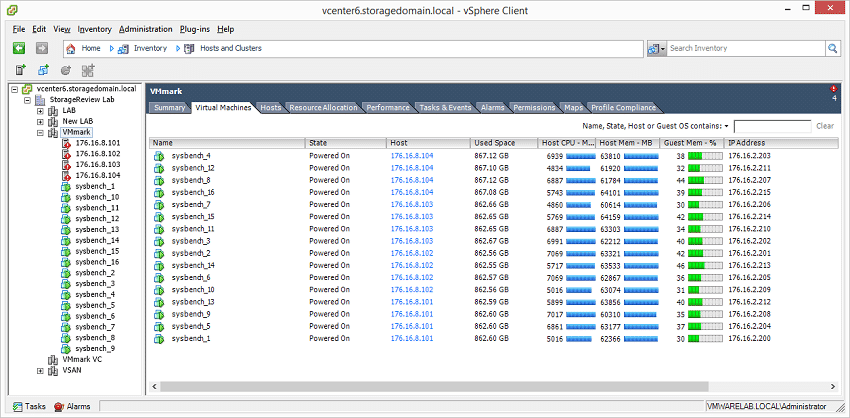
Our Sysbench test measures average TPS (Transactions Per Second), average latency, as well as average 99th percentile latency at a peak load of 32 threads.
Looking at average transactions per second, the XIO ISE 860 recorded 1,762 TPS when using one virtual machine with the R730. When boosting the configuration to 4 VMs, we saw a huge improvement in TPS to 4,424, which is an increase of roughly 150%. We also saw increases to performance when going from 4 VMs to 8VMs (38%) as well as 8 VMs to 12 VMs (9%). However, when increasing to 16 VMs, we saw a slight decrease in TPS by 7.4%. Even as the overall performance dipped at 16 VMs, the Dell PowerEdge R730 cluster backed by X-IO storage easily handled the workload.
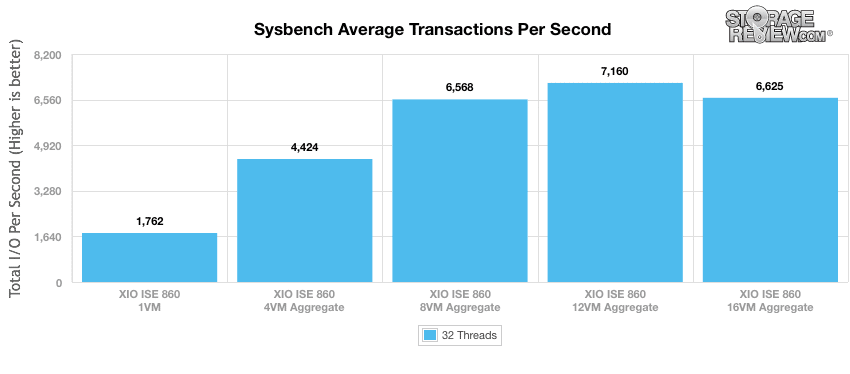
In average latency, it’s evident that the more virtual machines added, the higher recorded latency when leveraging the R730. When we changed the 1 VM configuration (18ms) to 4 VMs (29ms), latency increased by 61%. From 4 VMs to 8 VMs, we saw an increase of 34.5% while we recorded a 38.5% increase when moving from 8 VMs to 12 VMs. Lastly, when using 16 VMs, we measured a 48% in latency. Looking back to our above TPS chart, note that when using 12VMs, it offered the highest performance, whereas 16VMs started to decrease TPS as well as further increase latency.
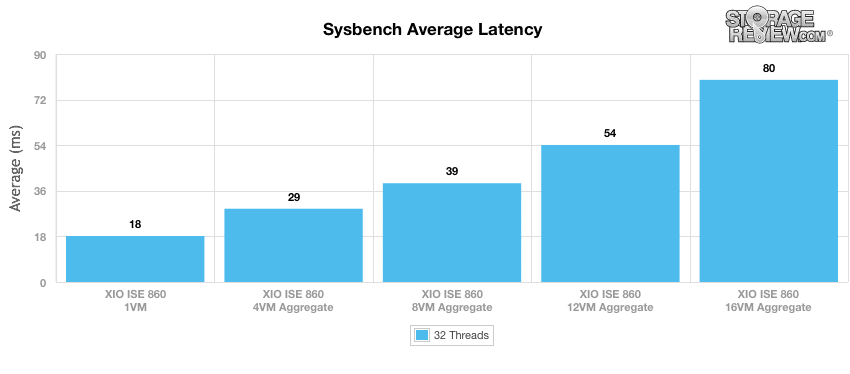
In terms of our worst-case MySQL latency scenario (99th percentile latency), the R730 allowed the latency to increase ever so slightly when moving from 1 VM to 4 VMs and again from 4 VMs to 8 VMs. When adding 12 VMs, however, we saw a significant 113% increase in latency all the while recording an even larger increase when moving from 12 VMs to 16 VMs (136%).
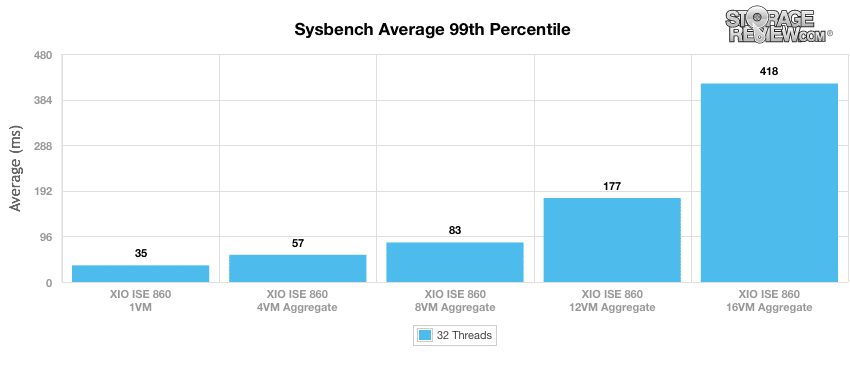
StorageReview’s Microsoft SQL Server OLTP testing protocol employs the current draft of the Transaction Processing Performance Council’s Benchmark C (TPC-C), an online transaction processing benchmark that simulates the activities found in complex application environments. The TPC-C benchmark comes closer than synthetic performance benchmarks to gauging the performance strengths and bottlenecks of storage infrastructure in database environments.
This test uses SQL Server 2014 running on Windows Server 2012 R2 guest VMs, being stressed by Dell's Benchmark Factory for Databases. While our traditional usage of this benchmark has been to test large 3,000-scale databases on local or shared storage, in this iteration we focus on spreading out four 1,500-scale databases evenly across our X-IO ISE 860 to better illustrate the aggregate performance inside a 4-node VMware cluster.
Second Generation SQL Server OLTP Benchmark Factory LoadGen Equipment
- Dell PowerEdge R730 VMware ESXi vSphere Virtual Client Hosts (2)
- Four Intel E5-2690 v3 CPUs for 124GHz in cluster (Two per node, 2.6GHz, 12-cores, 30MB Cache)
- 512GB RAM (256GB per node, 16GB x 16 DDR4, 128GB per CPU)
- SD Card Boot (Lexar 16GB)
- 2 x Mellanox ConnectX-3 InfiniBand Adapter (vSwitch for vMotion and VM network)
- 2 x Emulex 16GB dual-port FC HBA
- 2 x Emulex 10GbE dual-port NIC
- VMware ESXi vSphere 6.0 / Enterprise Plus 4-CPU
- Dell PowerEdge R730 Virtualized SQL 4-node Cluster
- Eight Intel E5-2690 v3 CPUs for 249GHz in cluster (Two per node, 2.6GHz, 12-cores, 30MB Cache)
- 1TB RAM (256GB per node, 16GB x 16 DDR4, 128GB per CPU)
- SD Card Boot (Lexar 16GB)
- 4 x Mellanox ConnectX-3 InfiniBand Adapter (vSwitch for vMotion and VM network)
- 4 x Emulex 16GB dual-port FC HBA
- 4 x Emulex 10GbE dual-port NIC
- VMware ESXi vSphere 6.0 / Enterprise Plus 8-CPU
Each SQL Server VM is configured with two vDisks, one 100GB for boot and one 500GB for the database and log files. From a system resource perspective, we configured each VM with 16 vCPUs, 64GB of DRAM and leveraged the LSI Logic SAS SCSI controller.
Leveraging the PowerEdge R730, the X-IO ISE 860 benchmarked in SQL Server test was certainly well qualified to handle 15,000 virtual users, as the Dell solution allowed the XIO ISE 860 to boast an aggregate average of 12,564.9 TPS.
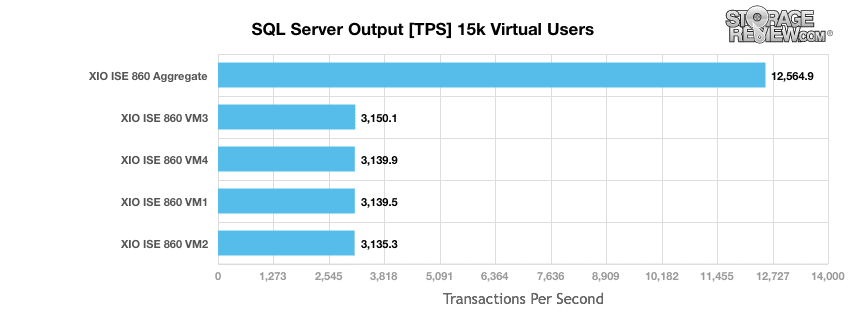
When looking at average latency with the same workload of virtual users, the R730 with X-IO storage offered an overall average 13ms latency, with a spread of 12 to 14ms between the 4 VMs.
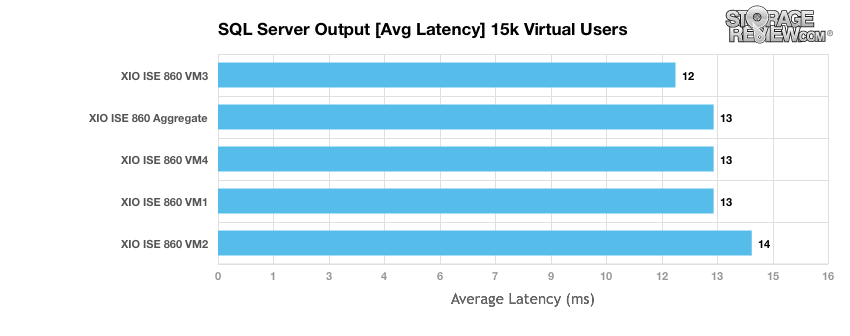
VMmark Performance
Dell PowerEdge R730 VMware VMmark 4-node Cluster Specifications
- Dell PowerEdge R730 Servers (x4)
- CPUs: Eight Intel Xeon E5-2690 v3 2.6GHz (12C/24T)
- Memory: 64 x 16GB DDR4 RDIMM
- Emulex LightPulse LPe16002B 16Gb FC Dual-Port HBA
- Emulex OneConnect OCe14102-NX 10Gb Ethernet Dual-Port NIC
- VMware ESXi 6.0
VMmark by its very design is a highly resource intensive benchmark, with a broad mix of VM-based application workloads stressing storage, network and compute activity. When it comes to testing virtualization performance, there is almost no better benchmark for it, since VMmark looks at so many facets, covering storage I/O, CPU, and even network performance in VMware environments.
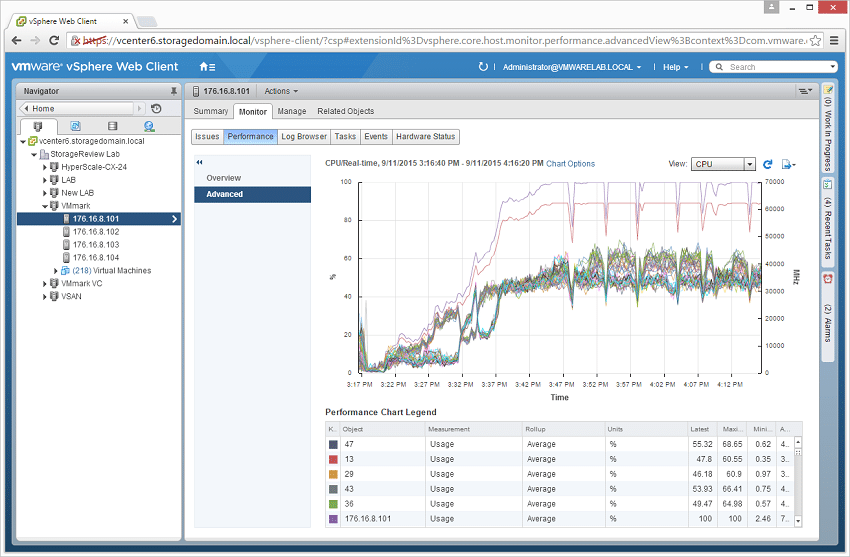
Dell PowerEdge R730 VMware VMmark 4-node Cluster Specifications
- Dell PowerEdge R730 Servers (x4)
- CPUs: Eight Intel Xeon E5-2690 v3 2.6GHz (12C/24T)
- Memory: 64 x 16GB DDR4 RDIMM
- Emulex LightPulse LPe16002B 16Gb FC Dual-Port HBA
- Emulex OneConnect OCe14102-NX 10Gb Ethernet Dual-Port NIC
- VMware ESXi 6.0
ISE 860 G3 (20×1.6TB SSDs per DataPac)
- RAID 10 Capacity: 22.9TB
In our initial look at VMware VMmark performance with the XIO ISE 860, we use the Dell PowerEdge R730 13G 4-node cluster as the driving force behind the workload. With eight Intel E5-2690 v3 Haswell CPUs, this cluster offers 249.6GHz of CPU resources for the applications running as a part of each VMmark tile. Generally we've seen a requirement of about 10GHz per tile, meaning this cluster under optimal conditions should be capable of running between 24-26 tiles. Beyond that adding additional servers into the cluster or switching to a higher-tier processor such as the E5-2697 v3 or E5-2699 v3 would be necessary. That is another way of saying that when this cluster gets topped out, the storage will most likely still have some headroom available to go higher.
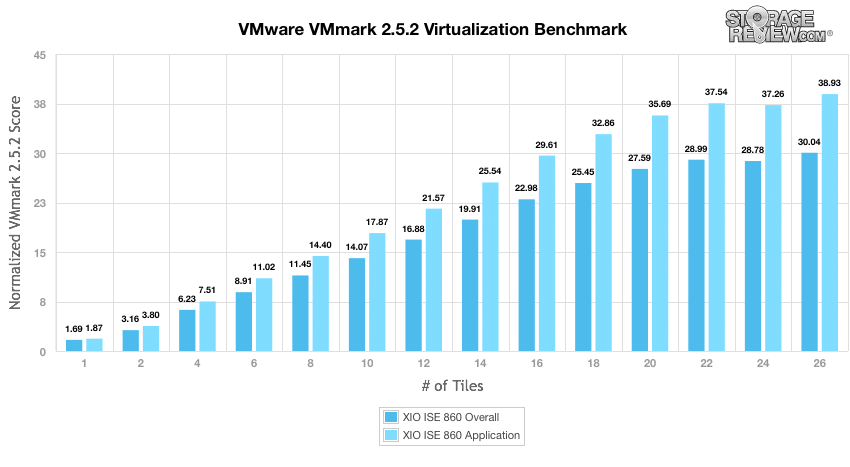
Scaling the VMmark workload on the XIO ISE 860, we saw a strong linear improvement from 1 to 22 tiles. After 22 tiles performance started to taper off slightly as our compute cluster pegged its CPU utilization. With a larger cluster the XIO ISE 860 could easily handle additional load. Diving into the performance monitoring behind the scenes backs that up, with latency measuring under 1ms during our 26 tile runs, with a handful of single-digit spikes during SVMotion/deploy actions. With low-latency performance being an absolute must for an all-flash array, the X-IO ISE 860 doesn't disappoint at all.
We will also look at the performance of a hyper-converged solution (VMware VSAN) deployed on the R730's brother the R730xd. This is more of offer an example of what the R730-family is capable of, since it was configured with 24-disks, whereas the standard R730 tops out at 16.
Using the Dell PowerEdge R730xd servers for this VSAN build gives us numerous advantages, as the server configuration leverages 24 front-mount SSD/HDD bays per node, in addition to an optional 2 extra flex bays in the rear for boot drives or supplemental storage. As a result, this provides fantastic density in a 2U form factor.
Dell PowerEdge R730xd VMware VSAN Specifications
- Dell PowerEdge R730xd Servers (x4)
- CPUs: Eight Intel Xeon E5-2697 v3 2.6GHz (14C/28T)
- Memory: 64 x 16GB DDR4 RDIMM
- SSD: 16 x 800GB Solid State Drive SAS Mix Use MLC 12Gbps
- HDD: 80 x 1.2TB 10K RPM SAS 6Gbps
- Networking: 4 x Intel X520 DP 10Gb DA/SFP+, + I350 DP 1Gb Ethernet
- Storage Capacity: 86.46TB
The 4-node Dell PowerEdge R730xd VSAN cluster was able to top out at 18 tiles in VMmark. 18 tiles is certainly an impressive ceiling, given that's where we've seen traditional storage arrays top out previously with a dedicated compute cluster. The Dot Hill Ultra48 with SSD tiering for instance came in at 18 tiles, with 800GB of flash and 9.6TB HDD capacity in RAID10. The Tegile HA2300, which exceeds the total cost of our VSAN cluster, topped out at 6 tiles with a dual-controller unit and an extra shelf, though to be fair, Tegile swaps performance for data reduction and ease of use. The R730xd cluster shows a great deal of performance in the emerging software-defined category which is why VSAN does so well here, but is also why Nutanix and others are using the R730/R730xd as the underpinning for their SDS offerings.
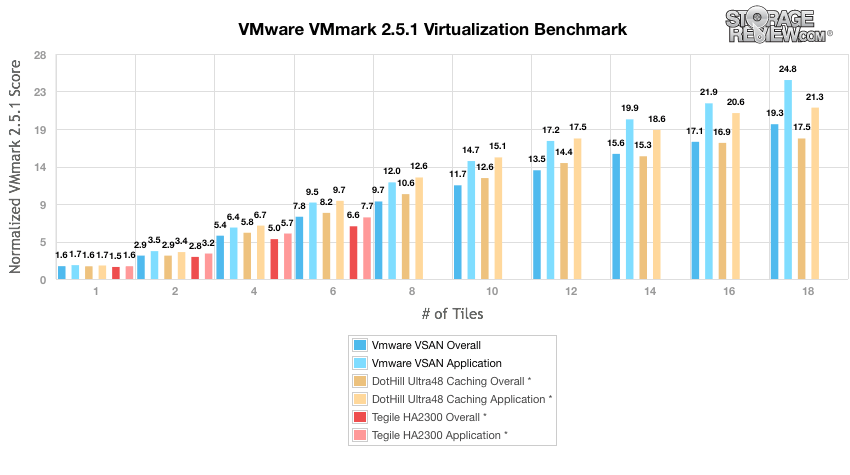
Conclusion
The Dell PowerEdge family is known for its versatility and industry-leading featuresets, the R730 is certainly no exception to this trend. The R730 offers the flexibility required for a host of applications as well as the ability to boast power needed for most high-performance workloads. The R730 is equipped with up to 16 bays with supported configurations of 16 x 2.5” drives or to 8 x 3.5” drives, which can mix and match SAS or SATA HDDs or SSDs. The server supports Intel Xeon E5-2600 v3 processors and 24 DIMM slots to cost-effectively scale up to 1.5TB of DDR4 memory. Additionally, the R730 has the ability to automate several of its management processes leveraging iDRAC8, which helps save administrators a substantial amount of time and energy with both updates and deployments.
We've leverage nearly a rack of Dell PowerEdge R730s on a near daily basis as the backbone of the StorageReview lab; they're also the load generators for all of our high-performance array reviews. In our recent review of the all-flash X-IO Technologies ISE 860 G3 for instance, we used a cluster of R730s in a VMware environment to stress MySQL, SQL Server and VMmark benchmarks. The PowerEdge R730s easily maintained their composure, driving strong application performance and very low latency results. The R730xd brings more disk flexibility to the portfolio. Our 4-node cluster configured for use with VSAN saw more virtualization capabilities and performance than many standard arrays and servers combined.
Dell’s PowerEdge R730 is clearly a worthy addition to their successful PowerEdge portfolio; offering impressive compute, memory and storage options in a standard 2U form factor. For users with larger storage needs, the company offers the R730xd model, which can be equipped with an extensive list of storage options. Ultimately, this is a server platform that is comprised of an intelligent design and excels in both server consolidation and management.
In terms of what you get for a mainstream server, the R730 has a lot to like for most traditional use cases while still maintaining the flexibility to do more should an application require flash or more memory. There's also the caching use case, where the user can leverage Dell Fluid Cache for SAN or DAS Cache to deliver great performance per dollar and of course the growing software-defined opportunity. While Dell offers other servers that are designed for specific uses, the R730 maintains its position as the utility tool in the Dell portfolio. With so many deployment models it's easy to worry about too much flexibility leading to gaps in capabilities. That hasn't been an issue in our lab; with 16 R730/R730xd servers providing the backbone for our lab on a daily basis the PowerEdge rack plows along ensuring peak application performance.
Pros
- Easy to maintain and manage
- Its compact 2U form factor offers substantial versatility
- DDR4 Memory creates a powerhouse server
Cons
- 2.5" NVMe support only on R730xd
Bottom Line
The Dell PowerEdge R730 offers everything expected from a mainstream server platform, delivering on configuration flexibility, management and build quality. The R730 is equally at home supporting high-performance business critical workloads in the data center as it is as part of a ROBO or small office configuration. Ultimately the R730 delivers to a wide array of use cases with ease and sophistication.


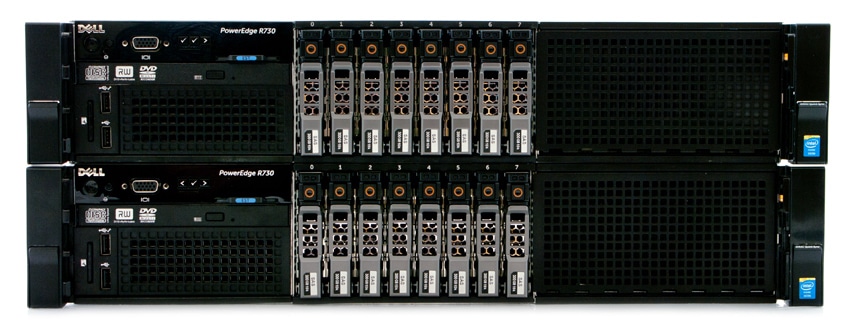
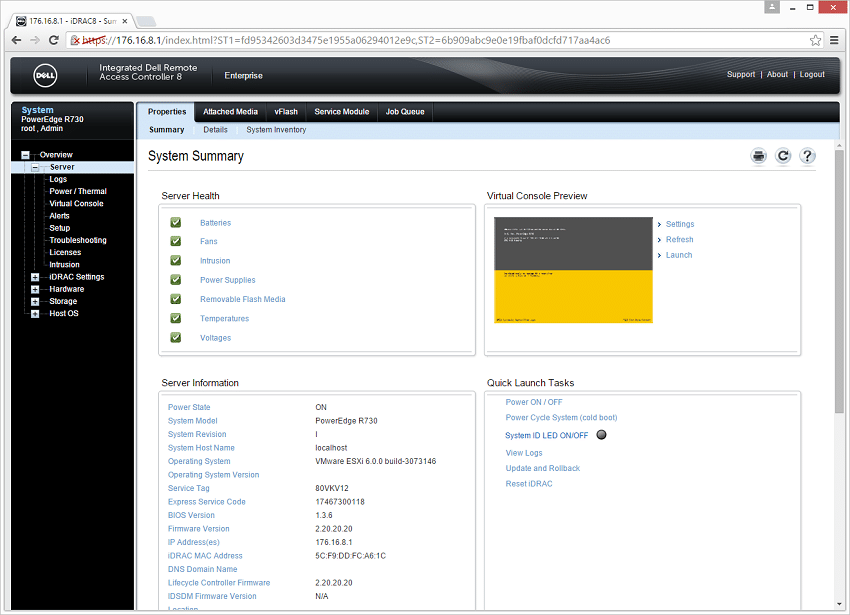


 Amazon
Amazon